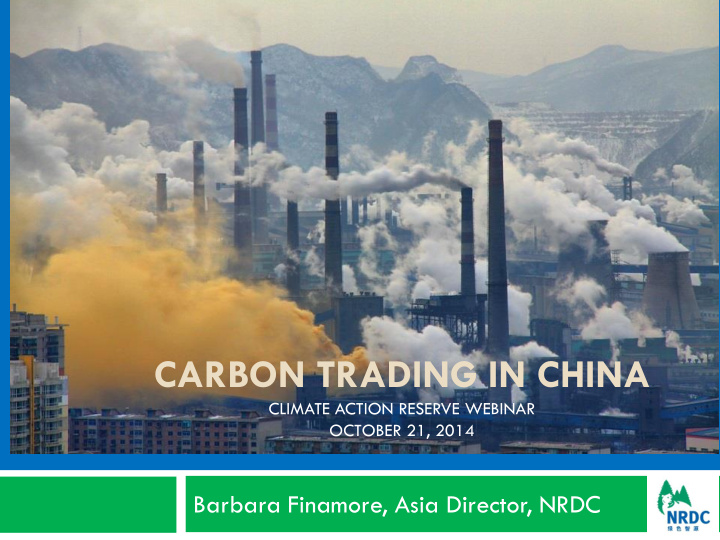



CARBON TRADING IN CHINA CLIMATE ACTION RESERVE WEBINAR OCTOBER 21, 2014 Barbara Finamore, Asia Director, NRDC
China’s Carbon Emissions Growth Annual CO 2 emissions now ~ 8300 MtCO 2 ; 28% of global total and more than US & EU combined China accounts for more than 60% of the increase in global emissions over the last decade Per capita emissions now higher than those of the EU and 45% higher than global average China is developing on a more carbon-intensive path than average, yet 16% of emissions associated with exports Sources: Global Carbon Project, CO2 Scorecard
When Will China’s CO 2 Emissions Peak? Vice Premier: “As soon as possible” China will announce post-2020 actions in early 2015 Possible target in 13 th Five Year Plan (2016- 2020) At current rate, China’s’ CO 2 emissions could rise to 12.7 billion by 2019 Yet coal consumption already dropping and may peak as soon as this year Sources: Reuters, US Climate Change Summit, Greenpeace
China’s Climate Change Efforts Implementing arguably the world’s largest energy efficiency and renewable energy programs National climate change plan to 2020 and targets for carbon intensity, reforestation, non-fossil energy, energy intensity, caps on energy/coal consumption Strong measures to curb air pollution through cuts in coal consumption and vehicle emissions; most but not all will also reduce CO 2 emissions Carbon trading launched; possible carbon tax
Overview of Carbon Trading in China Seven regional pilots launched and eighth program to launch in 2015; now the world’s 2 nd largest carbon market, covering 1,115 MTCO 2 e China has announced plans to launch national carbon market in 2016, second in Asia National market would cover 40% of economy, regulate 3-4 billion tonnes of CO 2 by 2020 and be worth up to $65 billion, largest in world Will bring in more emitting sectors in 2020 and seek ties to international markets in next decade Source: Reuters, Bloomberg, NY Times
Strengths/innovations of China’s carbon trading efforts If China sets a national price on carbon, others will follow Regional pilots allow experimentation with different systems In September, China bank lent $6.5 million to a chemical company using 4 million carbon permits as collateral Granted license to Finnish carbon trading firm to operate in three markets, second foreign company
Weaknesses of China Pilot Markets Lack of cap/unambitious emission reduction targets Lack of accurate data availability, especially # of permits and amount of CO 2 reductions Overallocation of free permits; could worsen in 2014 Lack of strong legal foundation Weak monitoring, reporting and verification Capacity building needed
Carbon trading pilot 1-Beijing Pilot began in Nov 2013, Beijing reports that CO 2 emissions from the city’s major polluters fell 4.5 % in 2013 - did not say how many tonnes were emitted or no. of permits issued About 2 million permits traded in 2013-2014; Total market value of just over $16.3 million; Average costs reportedly fell 2.5% Reported compliance 97.1% - inspections drove up prices to $11.94 in July, highest in world Will add 120 companies including public transport, universities, data centers, banks Source: Reuters
Carbon pilot 2 – Guangdong Province China’s biggest carbon market 2 million permits sold at auction in September at $4.20 each, 4% higher than minimum bidding price of 25 RMB Three more auctions to be held in this compliance year, mid-2014 to 6/2015 27 companies and 6 speculative private investors bid for 322 million permits Will hand out 6% more permits in 2014 Source: Reuters
Carbon trading pilots 3-Shanghai Launched in 2013 Issued 160 million permits to around 200 covered companies, Denied access to trading houses but said it will soon grant licenses to qualified trading companies Only 1.5 million permits traded in first year, none since June 30 Source: Reuters
Carbon trading pilot 4- Shenzhen Smallest and oldest pilot market; annual cap around 33 million permits Launched in June 2013, but only 1.55 million permits traded, around 60-70 RMB each Allows trades to be settled in foreign currencies, handled by Bank of China, to attract foreign traders Vows to impose sanctions and fines on companies that fail to comply with targets Source: Reuters
Carbon trading pilot 5 - Tianjin Covers 114 energy and industrial firms Twice extending compliance deadline Allocated permits covering 90 percent of allocated emissions to power and heat facilities Slow trading; 250,000 permits Source: Reuters
Other pilot markets Hebei Chongqing Qingdao approved to launch in 2015
Carbon Offset Market Companies covered by pilots can use offsets (CCERs) to meet 5-10% of compliance requirements China agreed to let 14 projects generate 6 million offset credits and sell into pilot carbon markets CCERs will likely be eligible for use in national market after 2016 Will sharpen competition between local exchanges, since national market will probably only have one or two exchanges Source: Reuters
Thank you! Barbara A. Finamore, Asia Director, NRDC Email: bfinamore@nrdc.org Mobile: +1 646 244 8222 (U.S.) +86 158 1072 8597 (China) +852 9019-9859 (Hong Kong) Visit our website: www.nrdc.cn Follow my blog: http://switchboard.nrdc.org/blogs/bfinamore/ Follow me on Twitter: @bfinamore
Recommend
More recommend